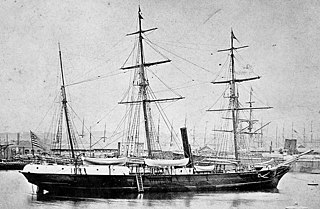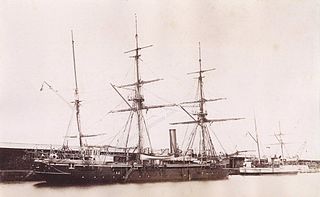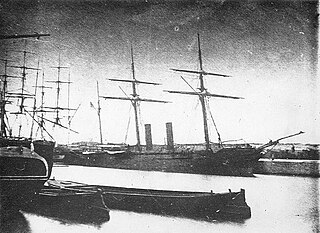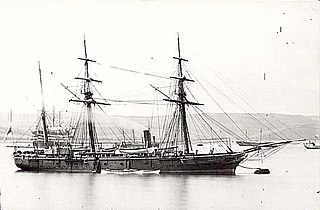Construction
The first 6 ships were ordered from commercial yards (Money Wigram & Son, C J Mare & Co and J Scott Russell), with fitting out to be done in the Royal Dockyards at Chatham (first pair) and Woolwich (last 4). A further batch of 4 ships (Sylvia - Myrmidon) were ordered on 5 March 1860 and another batch of 3 (Pegasus - Guernsey) on 25 March 1862. The first completed ships had a draught of 11–12 feet (3.4–3.7 m), exceeding the intended 8 feet (2.4 m) by a considerable margin. Since gunvessels were intended to work in shallow water while bombarding the shore, work on the later two batches was suspended. [2] Sylvia, Nassau and Myrmidon were suspended in 1862 or 1863, but were resumed, with Sylvia and Nassau being finished as survey vessels. [2] Tartarus was broken up on the slipway in 1865, having cost £6,268 and work to Pegasus cost only £339. Guernsey was never laid down. [2]

The Osprey class was a Royal Navy class of screw-driven sloops built between 1874 and 1877. Nine additional ships were built to a revised design, the Doterel-class sloop. They were the first class of ship in the Royal Navy to use glass scuttles.

The Camelion class was a class of screw-driven sloops of wood construction, designed by Isaac Watts and operated by the Royal Navy. Eight ships of the class were built from 1858 to 1866 with another eight cancelled. They were initially rated as second-class sloops, but were later reclassified as corvettes.

HMS Beagle was a wooden-hulled Arrow-class gunvessel second-class screw gunvessel launched in 1854 and sold in 1863. She was the third vessel of the Royal Navy to use the name.

The Algerine-class gunboats were a class of six 3-gun wooden gunboats built for the Royal Navy in 1857. A further pair were built in India for the Bombay Marine in 1859.

The Arrow class comprised six second-class screw-driven vessels built as despatch vessels for the Royal Navy in 1854, mounting 6 guns. In 1856 they were redesignated as second-class gunvessels.

HMS Surprise was a Vigilant-class gunvessel of the Royal Navy. She was launched at Blackwall Yard, London in 1856 and broken up in Plymouth in 1866.

The Vigilant-class gunvessel of the Royal Navy was an enlarged version of the Arrow-class gunvessel of 1854. Both classes were designed for shallow-water operations in the Baltic and Black Seas during the Crimean War. Fourteen of the class were completed, but were ready too late to take part in that conflict. Cormorant was sunk in action at the Taku Forts, Osprey was wrecked on the coast of Africa in 1867 and the rest were all sold during the 1860s, with Sparrowhawk lasting until 1872.

HMS Mullett was a Royal Navy 5-gun Philomel-class wooden screw gunvessel launched in 1860. She served on the coast of West Africa and on the North America and West Indies Station before being sold in 1872 at Hong Kong for mercantile use. As the sailing ship Formosa she sailed in the Far East before being converted to a magazine in Melbourne.

The Condor-class gunvessel was a class of four Royal Navy composite gunvessels of 3 guns, built between 1876 and 1877. They were all hulked or sold before 1893, giving them an active life of less than 15 years.

HMS Sparrowhawk was a Vigilant-class second-class despatch/gunvessel launched on 9 February 1856 at Limehouse, England and served at various stations in the Far East. By the spring of 1865, her rig was a converted to that of a three-masted barque. She was sold in 1872 and was eventually lost in a typhoon.

HMS Eclipse was a 4-gun Cormorant-class first class gunvessel launched in 1860 from the shipyard of J. Scott Russell & Co., Millwall. She served on the Australia Station, took part in the Second Taranaki War, including contributing men to a naval brigade which attacked the Maori stronghold at Gate Pā. The entire class were never satisfactory as gunvessels, partly due to their excessive draught, and Eclipse was broken up at Sheerness in 1867, only 7 years after her launch.

The Philomel-class gunvessel was a class of wooden-hulled screw-driven second-class gunvessels built for the Royal Navy between 1859 and 1867, of which 26 were ordered but only 20 completed. They had a mixed history, with some serving for as little as 5 years, and others surviving into the 1880s. Two of the class were sold and used as Arctic exploration vessels, both eventually being lost in the ice.
The Swallow-class sloop was a 9-gun wooden screw sloop class of four ships built for the Royal Navy between 1854 and 1857.

HMS Myrmidon was a Cormorant-class gunvessel of the Royal Navy, built at Chatham Dockyard and launched in 1867. She served on the North America and West Indies Station and surveyed parts of the Australian coast before being sold at Hong Kong in 1889.

HMS Rambler was an Algerine-class gunvessel of the Royal Navy, built by John Elder & Co., Glasgow and launched on 26 January 1880. She was commissioned as a survey vessel in 1884 and served in Chinese waters during the 1880s and 1890s. She provided men to a naval brigade during the Boer War and was sold on 23 January 1907.

The Ariel-class gunboat was a class of nine 4-gun composite gunboats built for the Royal Navy between 1871 and 1873. Although most were sold by 1890, one of them survived into the 1920s as a salvage vessel in private ownership. They were the first class of Royal Navy gunboat built of composite construction, that is, with iron keel, stem and stern posts, and iron framing, but planked with wood.

The Algerine-class gunvessel was a class of three Royal Navy composite gunvessels built in 1880. Two of them were sold after only ten years of service, but the other was converted to a survey ship before commissioning and survived in this role until 1907.

Intrepid-class gunvessels were a class of six Royal Navy first-class wooden gunvessels built in 1855-56. They were rated as sloops from 1859 to 1862, and were scrapped by 1865. Victor was sold to the Confederate States of America as the raider CSS Rappahannock, but she was interned by the French at Calais and never fulfilled her intended function.

The Arab-class gunvessels were a pair of composite gunboats built for the Royal Navy in the mid-1870s.

HMS Arab was an Arab-class composite gunvessel built for the Royal Navy in 1874. She served in the East Indies and was sold in 1889.
This page is based on this
Wikipedia article Text is available under the
CC BY-SA 4.0 license; additional terms may apply.
Images, videos and audio are available under their respective licenses.














